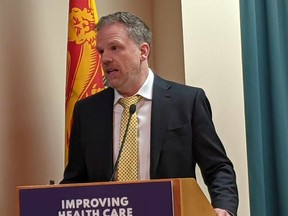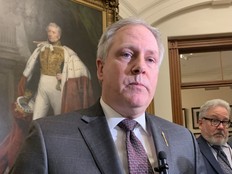What are federal targets for fixing N.B.'s health system?
Federal bilateral agreement requires the province to update public on health system projects

Article content
The province will be providing annual updates on improvements to the health-care and long-term care systems as part of two agreements with the federal government.
Advertisement 2
Story continues below
Article content
Last week, New Brunswick signed two bilateral agreements totaling $430 million to improve health care services and access, and to help seniors stay at home longer.
The Working Together agreement will provide more than $313 million to support New Brunswick’s three-year action plan, including more availability of primary care, recruitment initiatives, and expanded mental-health services.
The Aging with Dignity agreement will allot roughly $117 million to the province’s five-year plan for long-term care, including improvements to palliative care, strengthening the workforce, and increasing safety measures.
Federal Health Minister Mark Holland was in Moncton last week to sign the agreement. In a news conference, he noted the federal government is asking for reports from provinces for measurable data and indicators demonstrating the improvements using the money in the agreements.
“It needs to be rooted in evaluation, it needs to be rooted in data, it needs to be rooted in science,” he said last week.
Cecile Cassista, executive director of the Coalition for Seniors and Nursing Home Residents’ Rights, and Liberal health critic Rob McKee are among those who would like to see the timelines and targets for the projects included in the agreements.
McKee said in an interview Monday he would like to see quarterly updates from the province, especially on topics like access to primary care, health-staff retention, implementation of electronic medical records, and mental health service access.
Article content
Advertisement 3
Story continues below
Article content
“There has to be openness, transparency and accountability,” he said. “The government needs to take the dollars and use it for its intended purpose.”
So far, McKee said he has not seen the targets for the items mentioned in the agreements, but hopes to look at them soon.
Brunswick News asked the federal government for the benchmarks and targets that will be used to measure the progress of both agreements, and Health Canada provided a document for each agreement.
Funding for the agreements will be paid in semi-annual installments. The first installment is expected to be paid within 30 days of executing the agreement.
The agreements state the province must provide data to the Canadian Institute for Health Information. It must also update residents on the progress of initiatives outlined in the agreement.
Beginning with the 2024-25 fiscal year, the province must update the public on “headline indicators in the priority area(s) where federal funds are to be invested, and on jurisdiction-specific indicators for each of the initiatives tailored to their jurisdiction’s needs and circumstances.”
Additionally, the province must also notify the federal government with an annual financial statement and indicate the total amount of federal funding used in each of the priority health areas, as well as if there are any variances between actual expenditures and the action plan.
Health Department spokesperson Sean Hatchard said in an email Tuesday that New Brunswick agrees to provide data and information related to the common indicators to CIHI annually, no later than Oct 1, beginning with the 2024-25 fiscal year, but in the statement he did not say when the next update will be provided for the public.
Advertisement 4
Story continues below
Article content
Health system targets
According to a document provided by Health Canada, the improvements in the Working Together agreement must be completed by March 2026. Some of the targets are from CIHI and others are from New Brunswick’s health plan.
The indicators include having 90.9 per cent of New Brunswickers over the age of 12 having a family doctor, and 55.8 per cent of those with primary care provider being able to see their provider within five days.
For electronic medical records, the target is for 30 per cent of New Brunswickers to access their health information electronically, 25 per cent of physicians exchanging patient clinical summaries with doctors outside their practice, and for 75,000 New Brunswickers to their MyHealthNB records.
The backlog for surgeries delayed by COVID-19 would be eliminated, and 90 per cent of cataract surgeries would be performed within 22-180 days.
The target for median wait times for community mental health counselling would be 55 days with the median wait times for adult and youth one-at-a-time therapy being less than 10 days.
Hatchard said many of the items that are part of the action plan are initiatives that are already in place such as:
- Providing timely access to primary care services through NB Health Link for New Brunswickers who do not currently have a primary care provider while they wait to be matched with a permanent provider.
- Investing in enhancements to the Family Medicine New Brunswick model to improve access to primary care.
- Improving the provincial insulin pump program to help those living with diabetes have affordable access to devices and technology for the management and treatment of their disease.
- Expanding the scope of pharmacists to assess and prescribe for more illnesses and conditions.
- Creating an assessment program to help transition international medical graduates into the New Brunswick physician work force.
- Empowering communities in the promotion and integration of physicians, health-care workers and their families into their communities through the Community Promotional Funding Program.
- Reducing the wait times for and increasing the number of cataract surgeries completed via surgeries performed outside a hospital setting.
- Extending mobile X-ray services to long-term care residents across New Brunswick.
Advertisement 5
Story continues below
Article content
Some of the projects that have yet to be done include introducing HPV testing as a safe, reliable method of screening for cervical cancer, reducing the need for pap tests, establishing a population-based lung cancer screening program to assist in the early detection of lung cancer in high-risk patients, and enhancing addictions medicine management in a phased-in approach to put early emphasis on outpatient withdrawal services for alcohol use disorders.
Another upcoming initiative is the “clinical information solution,” which will bring clinical information into a single, consolidated source for health-care providers.
“Considerable work is required to ensure an efficient and coordinated implementation,” Hatchard said.
Funding breakdown
The document states annually there is $20 million of federal funding allotted towards improving primary care including $17 million for updating the “outdated” model of care, and $3 million for program improvements like the X-ray program, cancer screening, and making the insulin pump program more accessible.
Roughly $31.9 million of the funding is allotted for retention and recruitment, through financial incentives, creating a provincial sessional hospitalist model at the eight regional hospitals to replace family physician in-patient care, transitioning internationally trained staff into the workplace, allowing staff like nurses and personal support workers to work to their full scope of practice, and giving communities resources for recruitment and retention efforts.
Advertisement 6
Story continues below
Article content
There is $2.2 million for safety initiatives like creating a health safety and wellness strategy, having “recharge rooms” for health staff, hiring coordinators for a safe patient handling program and respirator testing program.
About $5.6 million is for addressing surgery backlogs, and $2.9 million to improve access to mental health and addictions services.
Approximately $29.4 million is for “creating a connected system” including $9.7 million for eVisitNB and NB Health Link, $19.7 million for creating a single consolidated “Picture Archiving and Communication System,” and a bilingual lab and clinical information system.
Article content












Postmedia is committed to maintaining a lively but civil forum for discussion. Please keep comments relevant and respectful. Comments may take up to an hour to appear on the site. You will receive an email if there is a reply to your comment, an update to a thread you follow or if a user you follow comments. Visit our Community Guidelines for more information.